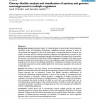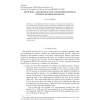44 search results - page 4 / 9 » Algorithms for Multiple Genome Rearrangement by Signed Rever... |
JDA
2008
13 years 7 months ago
2008
Abstract. Genome rearrangement algorithms are powerful tools to analyze gene orders in molecular evolution. Analysis of genomes evolving by reversals and transpositions leads to a ...
BMCBI
2007
13 years 7 months ago
2007
Background: Identifying syntenic regions, i.e., blocks of genes or other markers with evolutionary conserved order, and quantifying evolutionary relatedness between genomes in ter...
JCSS
2002
13 years 7 months ago
2002
Hannenhalli and Pevzner [5] gave a polynomial time algorithm for computing the minimum number of reversals, translocations, fissions, and fusions, that would transform one multichr...
CORR
2004
Springer
13 years 7 months ago
2004
Springer
Sorting by reversals is an important problem in inferring the evolutionary relationship between two genomes. The problem of sorting unsigned permutation has been proven to be NP-ha...
JCB
2002
13 years 7 months ago
2002
One possible model to study genome evolution is to represent genomes as permutations of genes and compute distances based on the minimum number of certain operations (rearrangemen...


